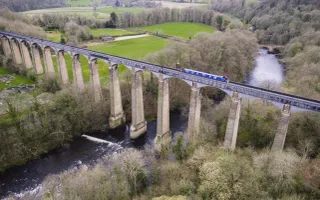Originally conceived by the Trustees of the Weaver Navigation as a way to transport goods between the River Weaver and the Trent & Mersey Canal, Cheshire’s famous boat lift has a rich and storied past.
Rolling back the years at Anderton Boat Lift
This year marks the 150th anniversary of Anderton Boat Lift, Cheshire’s iconic ‘Cathedral of the Canals’. To celebrate, we’ll be transporting visitors back in time to 1875, with a Victorian Fair.


Salt has been extracted from the Cheshire countryside ever since Roman times, and by the end of the 17th century, a major salt mining industry had sprung up around the towns of Middlewich, Nantwich, Winsford, and Northwich.
The completion of the River Weaver Navigation in 1734 provided a navigable transport route through Cheshire’s burgeoning ‘salt towns’, opening up lucrative trade links to Liverpool and beyond. But the real boom came with the completion of the Trent & Mersey Canal in 1777.
Built, principally, to serve the growing pottery industry in Staffordshire, the tributary carried raw materials and finished goods between Liverpool and towns like Stoke-upon-Trent, Hanley, and Fenton.
The canal runs alongside the River Weaver for several miles, and the owners of the respective waterways realised that if the two could be linked, cargo would flow much more easily. In 1793, they pooled their resources, excavating a basin on the north bank of the river at Anderton, near the town of Northwich.

Now, all that separated the two bodies of water was a small (if steep) strip of land. Cranes, salt chutes, and an inclined plane were installed to bridge the 50-foot slope, and before long, business was booming. Within a few short years, Anderton Basin had become a hub for local trade.
However, moving goods between the river and the canal wasn’t cheap, and as business continued to flourish, it became clear that a better, more cost-efficient solution was needed. After toying with the idea of building a flight of locks, the Trustees turned to their chief engineer, Edward Leader Williams, to draft plans for a boat lift.
True to form, Leader Williams came up with an innovative design which incorporated a pair of water-filled caissons (large, hollow, wrought-iron tanks), each capable of carrying two narrowboats or a single barge between the respective waterways.

According to Leader Williams’ concept, the two water-filled caissons would counterbalance one another, thus requiring relatively little power to hoist the vessels up and down. At the upper level, the canal would be connected to the boat lift via an aqueduct, with two sturdy wrought iron gates at either end.
To help realise his vision, Leader Williams drafted in fellow engineering luminary, Edwin[LP1] Clark. Hand-picked for his pioneering work in hydraulics, Clark was instrumental in designing and developing the lift’s complex hydraulic system.
Anderton Boat Lift was unveiled to the public on July 26 1875. A marvel of Victorian engineering, it created a vital interchange between the region’s bustling canal system and the Trent & Mersey Canal, facilitating the movement of goods between the Midlands, Liverpool, and the rest of the world. Thanks to the ingenuity and vision of Leader Williams and Clark, it would operate, almost without pause, for the next 100 years.
After being converted to electric power in 1908, the lift would continue to carry boats between the River Weaver and the Trent & Mersey Canal until the early 1980s. By then, commercial traffic had slowed to a crawl, and in 1983, after a routine inspection uncovered serious corrosion, Cheshire’s iconic boat lift was finally put out of commission.
In March 2002, after nearly two decades in the doldrums, Anderton Boat Lift was reopened. The visitor centre was added soon after, and the following year, then Prince of Wales, King Charles III, cut the ribbon at the official opening ceremony. Today, Cheshire’s ‘Cathedral of the Canals’ is more popular than ever, attracting thousands of visitors every year.
Later this month, we’ll be celebrating the 150th anniversary of this indomitable structure in style. Across the weekend of July 26 and 27, we’re hosting a spectacular, immersive Victorian Fair, with traditional games, music, and entertainment.
Join us, as we step back in time to mark 150 years since the opening of the world’s first major commercial boat lift – a remarkable feat of engineering and a true wonder of the Victorian age.
Last Edited: 1 October 2025


Stay connected
Sign up to our newsletter and discover how we protect canals and help nature thrive

